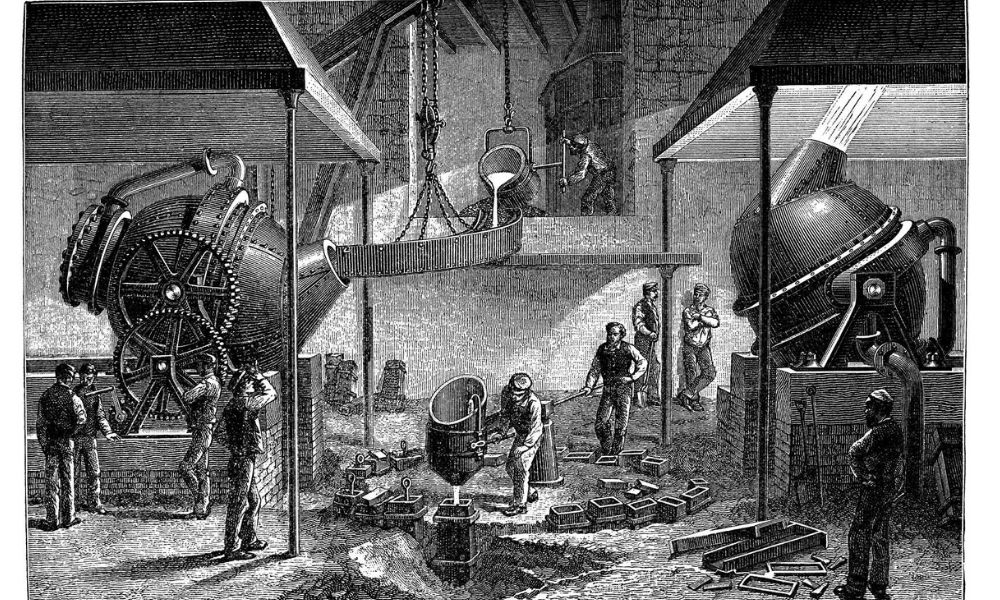The Industrial Revolution, which began in the late 18th century, brought about significant changes in the way goods were produced. It marked a shift from manual labor to machine-based manufacturing, leading to increased efficiency and productivity. However, the production of steel, a crucial component in the industrialization process, was still a time-consuming and expensive process. This all changed with the invention of the Bessemer process in the mid-19th century. This revolutionary method of steel production had a profound impact on various industries, transforming them and propelling them towards unprecedented growth. In this article, we will explore which industry benefited the most from the Bessemer process and how it shaped the modern world.
Contents
- 1 The Invention of the Bessemer Process
- 2 The Impact of the Bessemer Process on the Steel Industry
- 3 The Impact of the Bessemer Process on the Railway Industry
- 4 The Impact of the Bessemer Process on the Construction Industry
- 5 The Impact of the Bessemer Process on the Automobile Industry
- 6 The Impact of the Bessemer Process on the Shipbuilding Industry
- 7 The Impact of the Bessemer Process on the Weapons Industry
- 8 The Impact of the Bessemer Process on the Modern World
The Invention of the Bessemer Process
The Bessemer process was invented by British engineer Sir Henry Bessemer in 1856. It involved blowing air through molten pig iron to remove impurities and produce steel. This process was much faster and more cost-effective than the traditional method of producing steel, which involved heating and hammering iron to remove impurities. The Bessemer process not only reduced the production time from days to minutes but also significantly lowered the cost of steel production. This breakthrough innovation paved the way for the mass production of steel, which was crucial for the growth of various industries.
Read:What is a tax treaty benefit?The Impact of the Bessemer Process on the Steel Industry
The steel industry was the first to benefit from the Bessemer process. Before its invention, steel was a luxury item, and its production was limited to small quantities. The Bessemer process made it possible to produce large quantities of steel at a fraction of the cost, making it more accessible to industries and consumers. This led to a surge in demand for steel, and the industry experienced unprecedented growth.
- The production of steel in Britain increased from 125,000 tons in 1856 to 2.5 million tons in 1870, just 14 years after the invention of the Bessemer process.
- In the United States, steel production increased from 157,000 tons in 1867 to 4.2 million tons in 1890, a staggering 2,575% increase in just 23 years.
The Bessemer process also led to the development of new steel products, such as rails, beams, and girders, which were crucial for the construction of railways, bridges, and buildings. This further fueled the demand for steel and contributed to the growth of the steel industry.
The Impact of the Bessemer Process on the Railway Industry
The railway industry was one of the first to adopt the use of steel, and the Bessemer process played a significant role in its growth. Before the invention of the Bessemer process, railways were primarily built using iron, which was prone to rust and had a shorter lifespan. The use of steel, which was stronger and more durable, revolutionized the railway industry.
Read:What stores can i use my aetna healthy benefits cardThe Bessemer process made it possible to produce large quantities of steel at a lower cost, making it more affordable for railway companies to use in their construction projects. This led to the expansion of railway networks, connecting cities and towns and facilitating the transportation of goods and people. The use of steel also allowed for the construction of longer and heavier trains, increasing their carrying capacity and efficiency.
One of the most significant examples of the impact of the Bessemer process on the railway industry is the construction of the Transcontinental Railroad in the United States. The project, which began in 1863, aimed to connect the east and west coasts of the country. The use of steel, made possible by the Bessemer process, was crucial in the construction of this 1,912-mile-long railway, which was completed in 1869. This project not only transformed the transportation industry but also had a significant impact on the economic growth of the United States.
The Impact of the Bessemer Process on the Construction Industry
The construction industry was another major beneficiary of the Bessemer process. Before its invention, the construction of large buildings and structures was limited by the availability of iron, which was expensive and time-consuming to produce. The use of steel, made possible by the Bessemer process, revolutionized the construction industry.
Read:What is marginal benefitSteel was stronger, lighter, and more durable than iron, making it an ideal material for construction. The use of steel allowed for the construction of taller and more complex structures, such as skyscrapers, bridges, and stadiums. This not only transformed the skylines of cities but also made it possible to accommodate the growing population and meet their housing and infrastructure needs.
One of the most iconic examples of the impact of the Bessemer process on the construction industry is the construction of the Eiffel Tower in Paris, France. The tower, which was completed in 1889, stands at 1,063 feet and was the tallest man-made structure in the world at the time. The use of steel, made possible by the Bessemer process, was crucial in the construction of this iconic landmark.
The Impact of the Bessemer Process on the Automobile Industry
The automobile industry was another major beneficiary of the Bessemer process. Before its invention, the production of automobiles was limited by the availability of iron, which was heavy and not suitable for use in vehicles. The use of steel, which was lighter and stronger, revolutionized the automobile industry.
The use of steel in automobiles not only made them lighter and more fuel-efficient but also made them safer. The strength and durability of steel made it an ideal material for use in the construction of car frames, providing better protection to passengers in case of accidents. This led to an increase in the demand for automobiles, and the industry experienced significant growth.
One of the most significant examples of the impact of the Bessemer process on the automobile industry is the Ford Model T, which was introduced in 1908. The use of steel, made possible by the Bessemer process, was crucial in the production of this affordable and mass-produced car, which revolutionized the automobile industry and made cars accessible to the general public.
The Impact of the Bessemer Process on the Shipbuilding Industry
The shipbuilding industry was another major beneficiary of the Bessemer process. Before its invention, ships were primarily built using wood, which was prone to rot and had a shorter lifespan. The use of steel, which was stronger and more durable, revolutionized the shipbuilding industry.
The use of steel in shipbuilding not only made ships stronger and more durable but also made them more efficient. The lighter weight of steel allowed for larger ships to be built, increasing their carrying capacity and reducing transportation costs. This led to an increase in global trade and the growth of the shipping industry.
One of the most significant examples of the impact of the Bessemer process on the shipbuilding industry is the construction of the RMS Titanic, which was completed in 1912. The use of steel, made possible by the Bessemer process, was crucial in the construction of this luxurious and unsinkable ship, which was the largest and most advanced of its time.
The Impact of the Bessemer Process on the Weapons Industry
The weapons industry was another major beneficiary of the Bessemer process. Before its invention, weapons were primarily made of iron, which was heavy and not suitable for use in firearms. The use of steel, which was lighter and stronger, revolutionized the weapons industry.
The use of steel in weapons not only made them lighter and more efficient but also made them more lethal. The strength and durability of steel made it an ideal material for use in the production of firearms, leading to the development of more advanced and powerful weapons. This had a significant impact on warfare and the military industry.
One of the most significant examples of the impact of the Bessemer process on the weapons industry is the development of the Gatling gun, which was invented in 1861. The use of steel, made possible by the Bessemer process, was crucial in the production of this rapid-fire weapon, which revolutionized warfare and had a significant impact on the military industry.
The Impact of the Bessemer Process on the Modern World
The Bessemer process had a profound impact on various industries, transforming them and shaping the modern world. It revolutionized the production of steel, making it more accessible and affordable, and paved the way for the mass production of various goods. The use of steel, made possible by the Bessemer process, also led to the development of new products and industries, such as automobiles, railways, and skyscrapers.
The Bessemer process also had a significant impact on the global economy. The increased production of steel led to a surge in demand for raw materials, such as iron ore and coal, and created job opportunities in the mining and manufacturing sectors. The growth of industries, such as railways and shipping, also facilitated global trade and contributed to the economic growth of countries.
Conclusion:
The Bessemer process was a game-changer in the industrial world. It revolutionized the production of steel, making it more accessible and affordable, and had a profound impact on various industries, such as steel, railway, construction, automobile, shipbuilding, and weapons. The use of steel, made possible by the Bessemer process, transformed these industries and shaped the modern world. Its impact can still be seen today, and it continues to play a crucial role in the development of new technologies and industries.









